
The Bern Switzerland Temple is a temple of the Church of Jesus Christ of Latter-day Saints. It was the church's first temple in Europe and the second outside of North America, after the Laie Hawaii Temple. The intent to build the temple was announced on July 1, 1952, by church president David O. McKay.

The St. George Utah Temple, formerly known as the St. George Temple, is a temple of the Church of Jesus Christ of Latter-day Saints in St. George, Utah. Completed in 1877, it was the third temple constructed by the church and the first in Utah, following the westward migration of Mormon pioneers from Nauvoo, Illinois, after the death of church founder Joseph Smith.
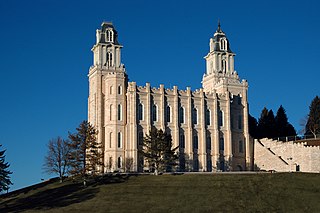
The Manti Utah Temple is the fifth constructed temple of the Church of Jesus Christ of Latter-day Saints. The temple construction was completed in 1888. Located in the city of Manti, Utah, it was the third Latter-day Saint temple built west of the Mississippi River, after the Mormon pioneers trekked west. The Manti Temple was designed by William Harrison Folsom, who moved to Manti while the temple was under construction. The temple dominates the Sanpete Valley and can be seen from many miles. Like all Latter-day Saint temples, only church members in good standing may enter. It was previously one of only two remaining Latter-day Saint temples in the world where live portrayal was used in the endowment ceremony. All other temples use a film in the presentation of the endowment, a practice that will also be used in Manti beginning in 2024 following renovation. It is an early pioneering example of four rooms representing the journey of life.

The Cardston Alberta Temple is a temple of the Church of Jesus Christ of Latter-day Saints in Cardston, Alberta. It was the eighth temple constructed and is the sixth still in operation. The intent to build the temple was announced on October 12, 1912, by church president Joseph F. Smith, during the church's general conference. It was both the first temple built in Canada and outside the United States. There are four temples in the province of Alberta and ten operated by the church in Canada.
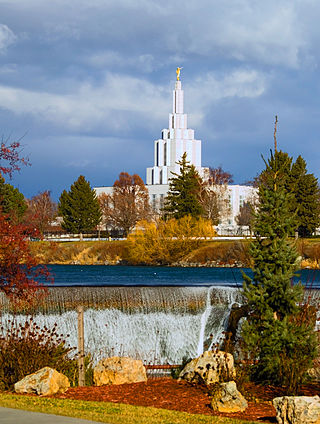
The Idaho Falls Idaho Temple is a temple of the Church of Jesus Christ of Latter-day Saints in Idaho Falls, Idaho. The intent to build the temple was announced on March 3, 1937, by church president Heber J. Grant during the church's general conference. It is the church's tenth constructed and eighth operating temple, the first built in Idaho, and the first built with a modern single-spire design.

The Hamilton New Zealand Temple is the 13th constructed and 11th operating temple of the Church of Jesus Christ of Latter-day Saints. The intent to build the temple was announced on February 17, 1955, by church president David O. McKay during a meeting of the First Presidency and Quorum of the Twelve Apostles. With its completion in 1958, it was the church's first temple in the Southern Hemisphere, the second built both in Polynesia and outside the United States and Canada, after the Laie Hawaii Temple. Located just outside Temple View in Hamilton, it was built with a modern single-spire design similar to the Bern Switzerland Temple. As of May 2024, this is the only temple currently operating in New Zealand, with one in Auckland under construction, and another in Wellington in the planning phase.

The Provo Utah Temple was a temple of the Church of Jesus Christ of Latter-day Saints located in Provo, Utah, just north of Brigham Young University (BYU). The intent to build the temple was announced on August 14, 1967, by Hugh B. Brown and N. Eldon Tanner. The church's temples are a sacred space where church members make covenants and perform ordinances for themselves and their deceased ancestors. The temple was designed by architect Emil B. Fetzer and was dedicated in 1972 as the church's seventeenth constructed and fifteenth operating temple. It was the sixth temple built in Utah, and the first in both Utah County and Provo.

The Ogden Utah Temple is the sixteenth constructed and fourteenth operating temple of the Church of Jesus Christ of Latter-day Saints. Located in Ogden, Utah, it was originally built with a modern, single-spire design, similar to the Provo Utah Temple. The temples in Ogden and Provo were designed to be sister temples and are the only ones dedicated by church president Joseph Fielding Smith. The temple became the church’s fifth in Utah, and second along the Wasatch Front, dedicated almost 79 years after the Salt Lake Temple. It was the first to be dedicated in the state of Utah, as the previous ones were dedicated when Utah was still a territory.
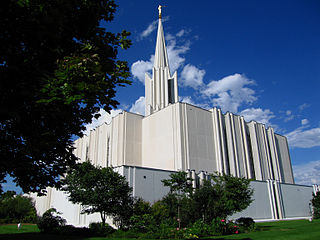
The Jordan River Utah Temple is the 20th operating temple of the Church of Jesus Christ of Latter-day Saints, located in South Jordan, Utah. The intent to build the temple was announced on February 3, 1978, by church president Spencer W. Kimball during a press conference in the Church Office Building. The temple is the first in the city of South Jordan, the second in Salt Lake County, and as of 2024 is one of thirty in the state of Utah.

The Palmyra New York Temple is the 77th operating temple of the Church of Jesus Christ of Latter-day Saints. The intent to build the temple was announced on February 9, 1999. It was the first temple built in New York.
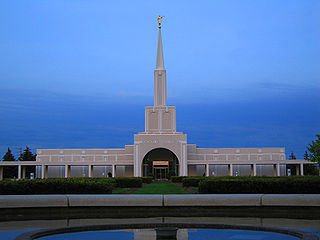
The Toronto Ontario Temple is the 44th operating temple of the Church of Jesus Christ of Latter-day Saints. The intent to build the temple was announced to local leaders on the morning of April 7, 1984, and then referenced by Gordon B. Hinckley, second counselor in the First Presidency, during the general conference session which followed. It was the second temple built in Canada, becoming the first country in the world, outside the United States, to have two temples in its borders.

The Suva Fiji Temple is the 91st operating temple of the Church of Jesus Christ of Latter-day Saints. The intent to build the temple was announced on April 5, 1998, by church president Gordon B. Hinckley during the church's general conference. The temple is the first to be built in Fiji.

The Draper Utah Temple is the 129th temple of the Church of Jesus Christ of Latter-day Saints. It was dedicated by church president Thomas S. Monson on March 20, 2009, with additional sessions also held through March 22. The intent to build the temple was announced by church president Gordon B. Hinckley on October 2, 2004, during the church's general conference. Prior to the dedication, the temple was open to the public from January 15, 2009 through March 14, 2009.

On December 27, 1832, two years after the organization of the Church of Christ, the movement's founder, Joseph Smith, stated he received a revelation that called upon church members to restore the practice of temple worship. The Latter Day Saints in Kirtland, Ohio were commanded to:
"Establish a house, even a house of prayer, a house of fasting, a house of faith, a house of learning, a house of glory, a house of order, a house of God."
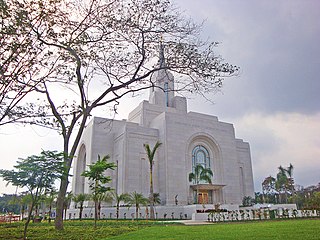
The San Salvador El Salvador Temple is the 135th temple of the Church of Jesus Christ of Latter-day Saints. It is the fourth temple to be built in Central America and the first in El Salvador. The intent to build the temple was announced on November 18, 2007, in a statement from the church's First Presidency.

The Provo City Center Temple is a temple of the Church of Jesus Christ of Latter-day Saints, built on the site of the former Provo Tabernacle in Provo, Utah. Completed in 2016, the temple uses much of the external shell of the tabernacle that remained from the original building after a fire in December 2010. The intent to build the temple was announced on October 1, 2011, by church president Thomas S. Monson, during the church's general conference. The temple is the second in Provo, was the sixteenth in Utah, and the church's 150th worldwide. This temple has a distinctive exterior with Gothic-inspired stained glass windows. A groundbreaking ceremony, to signify the beginning of construction, was held on May 12, 2012, conducted by Jeffrey R. Holland.

The Orem Utah Temple is a temple of the Church of Jesus Christ of Latter-day Saints located in Orem, Utah. The intent to build the temple was announced on October 5, 2019, by church president Russell M. Nelson, during the church's general conference. The temple is the first in the city of Orem, the sixth in Utah County, and the 28th in the state of Utah.

The Deseret Peak Utah Temple is a temple of the Church of Jesus Christ of Latter-day Saints in Tooele, Utah. Plans to construct a temple in the Tooele Valley were announced on April 7, 2019 by church president Russell M. Nelson, during general conference. The temple is the first in Tooele County and the 23rd in the state of Utah.
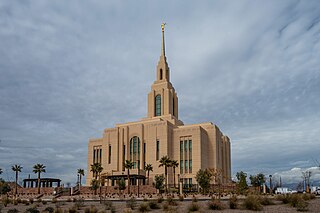
The Red Cliffs Utah Temple, originally announced as the Washington County Utah Temple, is a temple of the Church of Jesus Christ of Latter-day Saints in St. George, Utah. The intent to construct the temple was announced in October 2018 by church president Russell M. Nelson. It is the second temple in Washington County, with the St. George Utah Temple being the first, and the fourth in southern Utah.


























